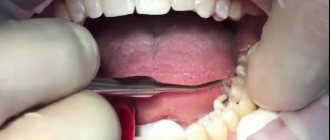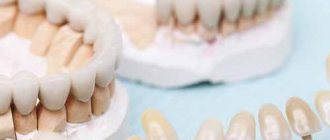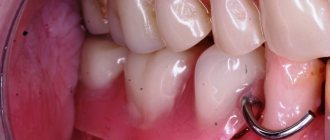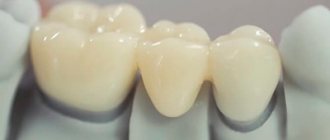Without exaggeration, zirconium crowns are a universal and technologically advanced orthopedic design. Strength and durability, like metal. And the aesthetics are like ceramic dentures. At the same time, dental crowns are comfortable and safe to wear, do not cause allergies, and do not harm the body.
In addition, a zirconium dioxide prosthesis can be installed on any dental unit - in the front row, on molars and premolars. The design is also suitable for fixing bridges of 2-3 teeth. Service life with proper use is from 10 to 15 years. Now more details.
Peculiarities
Modern prostheses are made from natural stone, zircon, which is white. Externally, the material resembles real teeth, and in terms of hardness and strength it is often compared to metal. Like everything natural, zirconium dioxide crowns are completely compatible with the human body, take root well and do not cause discomfort when worn constantly. Unlike metal ceramics, a zirconium prosthesis does not cause darkening of the gums, galvanism, and is suitable for people with high sensitivity to foreign materials.
The prosthesis is made using CAD/CAM computer technology - a painstaking and complex process that requires highly qualified doctors and dentists. This explains the high cost of the orthopedic design.
But if you look at the characteristics of zirconium crowns, it becomes clear that the investment is completely justified:
- The strength of the material is 2.5 times higher than that of ceramics (900-1000 MPa).
- The automated manufacturing process reduces the risk of errors, unlike manual production. The technology is so precise that often after installing crowns, additional grinding and turning of the prosthesis is not required.
- The aesthetic properties of a zircon prosthesis are slightly worse than porcelain crowns. They have lower capacity (less transparent). However, from the outside, it is difficult even for a specialist to distinguish zirconium crowns from real natural teeth.
How teeth are treated for zirconium and metal-ceramic crowns
Before installing a zirconium crown or other types of artificial crowns, the teeth must first be prepared.
Turning for a zirconium crown
If we talk about zirconium crowns, then due to the zirconium dioxide in their base, the alloy is initially light in color, then for coating with ceramics, it does not need to be further masked by covering with special ceramic primer materials.
Due to this, the thickness of zirconium crowns can be less than the thickness of metal-ceramic crowns based on noble and base metals; accordingly, the degree of tooth processing for such a crown, grinding, will be less.
It is often possible to prepare teeth for zirconium crowns without first removing the nerves from them, of course, taking into account all medical indications and the condition of each specific tooth, but often crowns can be placed on living teeth.
Preparing a tooth for a metal-ceramic crown
If we are talking about metal-ceramic crowns, then due to the thickness of the crown, which contains a metal alloy, which still needs to be aesthetically closed so that it does not show through, and covered with ceramics, due to a certain number of layers of ceramics, a more vibrant appearance corresponding to the teeth is given.
The thickness of metal-ceramic crowns turns out to be greater, and often when preparing teeth for such crowns, it is necessary to remove the nerves of the teeth, in order to depulpate the teeth, so that there are no complications in the future if the tooth under such a crown hurts due to inflammation of the nerve.
Teeth from which the nerves have already been removed are, by default, less durable than living teeth.
Although, in certain situations, it is sometimes necessary to depulpate teeth under both types of crowns, this depends on medical indications, contraindications to depulpation, and removal of nerves from teeth.
Varieties
The issue of aesthetics helps to decide the type of design and manufacturing method. There are classic and monolithic types of crowns.
In the first case, a zirconium base is used as a frame. And ceramics are applied on top in several layers. Thus, the design perfectly combines the strength of zircon and the impeccable aesthetics of ceramics.
Monolithic crowns are made from a single block, without additional cladding. But the mineral in its “pure form” has a milky tint, and differs from natural teeth. Therefore, monolithic zirconium crowns are used to restore chewing teeth.
The second type of prosthesis is more reliable, because eliminates possible chips on metal-free ceramics. To improve aesthetics, manufacturers began to produce colored zircon blocks (for example, Prettau technology). These crowns can be used to restore teeth in the smile area.
There is a material similar in external properties to zirconium dioxide - aluminum oxide. But the design is less durable, so it is used less often and only for prosthetics of the front teeth.
Family dentistry is among the TOP 5 best clinics in Moscow 2017
Family Dentistry is the winner of the professional rating of the Kommersant Publishing House and the online publication about dentistry Startsmile for 2022.
Participation in the Startsmile rating is free for clinics, and the evaluation system is objective and unbiased, which is guaranteed by the absence of financial benefits for the rating organizers and the transparency of scoring.
The rating of our clinic consists of many nuances:
- Partnership with the world's leading implant manufacturer Straumann.
- Application of 3D technologies in prosthetics and implantation.
- Expert equipment from Germany (KaVo) for diagnosis and treatment.
- Providing 3 types of guarantees for dental implantation.
- Regular training of our specialists in the best foreign clinics.
Advantages of zirconium dioxide crowns
The popularity of zirconium crowns is due to many advantages.
The main thing is strength, which we have already talked about. Let us only add that the reliability of the prosthesis is confirmed by its use in complex bridge structures. The material is also used for prosthetics of the entire jaw, with complete or partial edentia. The second argument in favor of zircon is minimal grinding of the tooth when installing a prosthesis. The thickness of the crown is not at all large, so no more than 0.3-0.5 mm of enamel is removed from the supporting tooth. If the tooth is healthy and the pulp is not inflamed, then the dental nerve remains inside the tooth. This allows you to save your natural tooth for the maximum period, even if it is severely damaged.
Interestingly, throughout the entire period of use, zirconium dioxide crowns retain their external qualities. The surface of the prosthesis does not darken and is not subject to pigmentation. Zircon is also resistant to temperature changes, so the patient does not have a reaction to hot or cold food.
Making a prosthesis using digital technology ensures a tight fit of the internal cavity of the artificial tooth to the stump. This prevents the dental cement on which the prosthesis is attached from being washed out. As well as food getting and getting stuck inside the structure.
Installation steps
1 Preparation
2 Taking impressions
3 Making a crown
4 Fitting, fixation
Includes: radiography, sanitation of the oral cavity, preparation of enamel, strengthening of the root with a stump insert (if necessary).
Using a digital camera, the doctor scans the tooth to be replaced. The resulting images are loaded into a computer program to model the frame of a future orthopedic structure. The clinic uses 3D scanning technology with blue backlight, which has replaced the outdated white backlight technology. It reduces sensitivity to ambient light and increases scanning quality/accuracy.
In a dental laboratory, an orthopedic structure is cut out on a milling machine according to a computer-specified shape.
The doctor tries on the crown and, if the patient does not experience any discomfort, fixes it onto the abutment tooth with dental cement. If the prosthesis is installed on an implant, it is screwed on.
Cons of zirconium crowns
Prostheses made of zirconium are considered the most expensive among their analogues, in terms of the cost of material and manufacturing methods. In addition, the ceramic layer in the classic design of zirconium crowns is less durable. Chips may appear on the surface of the tooth, and the structure will have to be repaired or replaced.
The imperfection of aesthetics also falls into the “cons” column. Monolithic zirconium cannot convey the natural translucency of tooth enamel, so with a single tooth replacement it may look unnaturally white. However, if you restore the entire front row, there will be no problems with aesthetics.
Due to its strength, the material can wear away the enamel of neighboring teeth. The degree of abrasion is insignificant, but it is necessary to visit an orthopedic dentist periodically, once every six months, to prevent the destruction of healthy teeth.
Features of care
Zirconium dentures do not require special care. The set of procedures does not differ from standard daily care for natural teeth:
- regular brushing with toothpaste without solid particles (containing abrasives);
- preference should be given to brushes designed for cleaning dentures;
- rinsing the mouth after eating;
- use of special superfloss threads.
The high strength of zirconium products allows you to consume products without any restrictions. Apples, carrots, hard chocolate and similar foods can be safely bitten with new teeth. However, you should not chop nuts, ice, or candy with the help of dentures.
A prerequisite for care is to visit the dentist at least once a year. Following the recommendations extends the life of artificial teeth, eliminating side effects such as cracks and chips.
Production process
As mentioned above, zirconium dental crowns are made using CAD/CAM computer technology. The first part of the abbreviation stands for computer modeling of prostheses. And CAM is the subsequent milling of crowns according to the developed three-dimensional model.
In other words, “manual” intervention in the process is minimized. This eliminates possible errors in the production of the structure associated with the human factor.
The prosthesis manufacturing process consists of several stages:
- To transfer data to the program, the dentist scans the oral cavity with a special scanner. This is done immediately after treating the supporting teeth.
- The program develops a virtual model of the jaw with a new prosthesis. At the same time, the doctor selects the shade for the crown according to the Vita scale.
- Based on the calculations, a three-dimensional model of the prosthesis is created, according to which a zirconium dioxide crown will be made using a milling cutter.
- The finished product is subjected to heat treatment. If the prosthesis is two-layer, then the zirconium dioxide base is “baked” first, and then a second time after lining with ceramics.
At the final stage, the dentist paints the crown in the desired shade and transfers the structure to the dentist. Production of the prosthesis takes 1-2 weeks, depending on the complexity of production.
Manufacturing stages
Zirconium dioxide is used to make two types of crown designs:
- Monolithic , consisting entirely of zirconium dioxide. They are characterized by increased strength, reliability, and a high degree of abrasion. Recommended for chewing teeth that do not require increased aesthetic beauty.
- Two-layer based on a zirconium dioxide frame with an applied outer porcelain layer. They are used for prosthetics of the frontal area - the “smile zone”. They have the aesthetic color and transparency of a natural human tooth.
High-tech equipment is used to produce zirconium crowns. The process is fully automated and occurs without human intervention using the CAD\CAM method. Includes several stages:
- computer development of a three-dimensional model of the future prosthesis;
- loading the finished 3D model into the control unit of the milling machine;
- creation of a frame made of zirconium dioxide according to specified parameters;
- firing in a special oven;
- application of several layers of porcelain by hand by a technician with sequential firing of each layer;
- manually applying the selected shade of dye;
- final firing.
The shade of the dye is selected according to the color of the patient’s natural tooth enamel. The service life of zirconium crowns is 15-20 years.
Bridges for any number of teeth are made from zirconium dioxide. They are a structure of individual crowns connected together, the outermost of which have a hollow structure. Bridges are mainly made non-removable. However, the possibility of a removable denture is not excluded. The design is supplemented with locks if necessary.
For the manufacture of dentures, three types of zirconium blanks are used, depending on the level of translucency (light transmission):
- Non-translucent with maximum strength up to 1500 mPa. They are used for prosthetics for patients with malocclusion and the absence of several teeth. Finished dentures are colored by placing them in a special composition before firing.
- Increased translucency with a strength of 900 mPa. Used to create individual crowns and bridge structures. Painting is done manually on the inside and outside with special brushes before firing.
- Ultra translucent with a strength of 1100 mPa and a light transmittance of 30%. They are used to create individual crowns and veneers that are particularly aesthetically attractive. The coloring process is identical to the process for products made from non-translucent zirconia compounds. Most often, this variety is used for crowns in the “smile zone”. Can be used to make bridges with no more than three teeth.
Installation of crowns
The procedure for fixing a zirconium dioxide crown to a tooth is standard. First, the doctor conducts an initial examination and diagnosis of the jaw to determine the condition of the oral cavity. If the patient requires preliminary treatment, the installation of the prosthesis is postponed until therapy is carried out.
If there are no pathologies, the dentist carries out professional teeth cleaning to remove soft and hard plaque. Then the doctor begins to grind the restored teeth. If the tooth is severely damaged, a pin, inlay or implant can be used as support.
If the root of the tooth is not damaged, then it is filled and the font is fixed on top. If the patient is allergic to metal, then a rod made of zirconium or titanium can be used. This method is not applicable in the presence of periodontal pathologies. And also in the presence of diseases of the nervous system.
The stump tab is also installed in the sealed root canal and ensures reliable fastening of the prosthesis. But the most common technique is fixing a zirconium crown to an implant. It is used when a tooth is missing. The titanium rod imitates a tooth root, preventing bone tissue atrophy. The material is biocompatible with the human body and fuses seamlessly with the jaw bone.
The process of attaching the crown to the supporting tooth or pin takes about 30 minutes. The structure is fixed with dental cement under the influence of light. Sometimes a so-called “temporary mixture” is used so that the patient can test the prosthesis as usual. If defects appear during wearing, the design is sent to the laboratory for revision. At the final stage, the zirconium crowns are placed on the support using dual-curing cement.
Prices
The cost of a ceramic zirconium crown consists of:
- the need for and scope of therapeutic measures in the process of preparation for prosthetics;
- type of prosthesis (classic two-layer or monolithic in full anatomy); zirconium crowns for front teeth with ceramic coating are more expensive;
- use of high-precision equipment for the manufacture of prostheses;
- the need for preliminary installation of an artificial root - implant;
- having your own dental laboratory or more expensive contractual relationships;
- qualifications of specialists;
- reputation and geographical location of the clinic.
On average, the price for installing a crown on a zirconium tooth in dental clinics in large cities (Moscow, St. Petersburg, etc.) ranges from 25 to 50 thousand rubles.
Adaptation
The procedure for fixing zirconium crowns does not have a recovery period. The only restriction is not to eat food for 2-3 hours after installation of the prosthesis.
Of course, at first you may experience unusual sensations from the presence of a foreign structure in your mouth. There may be slight disturbances in diction, increased salivation, and discomfort in the facial muscles. As a rule, these sensations disappear after a few days, after the patient gets used to the new teeth. If discomfort persists or worsens, you should immediately consult a dentist. You should not try to straighten the structure yourself - this can lead to its breakdown and health problems.
Material advantages
Zirconium dioxide is superior in many respects to other materials used for prosthetics. It makes it possible to obtain crowns that:
- They have a small thickness. Unlike metal-ceramic prostheses, zirconium oxide crowns are thin-walled. Therefore, there is no need to grind down a large amount of dental tissue under them. And, accordingly, depulpation is not required, that is, the tooth remains alive.
- They fit as accurately as possible to the supporting part. In the manufacture of such crowns, computer modeling technologies are used, so the dentures fit tightly and hermetically to the gums, and bacteria do not penetrate under them.
- They look natural. Zirconium dioxide is distinguished by such properties as light conductivity and transparency, which corresponds to the characteristics of natural enamel. Therefore, crowns made from it are very similar to real teeth.
- Biocompatible with body tissues. Zirconium dioxide does not cause irritation in the oral cavity, does not provoke allergic reactions and does not stain the gums in the area adjacent to the crown.
- They do not chip or crack. Such crowns are so strong that they can even be installed on chewing teeth, including as part of bridge structures.
- They do not lose their original characteristics over time. With proper care, even after several years of use, dentures retain their color and shine.
Lifetime
A zirconia prosthesis does not have a fixed service life. On average, this is 10-15 years. With careful care and wear, crowns can last much longer. This depends on the condition of the teeth, the quality of the installation of the prosthesis and regular oral hygiene.
What can cause damage or damage to the structure:
- Lack of tightness. The reason is usually careless handling of the prosthesis, as well as poor quality material.
- Recession (exposed gums). Occurs due to inflammation in soft tissues. Or due to improper hygiene.
- Destruction of hard tooth tissues (periodontal disease, bruxism, inflammation).
Dental trauma caused by eating hard foods or lack of calcium in the body can also damage the prosthesis.
Indications
1
The tooth is destroyed
2 Tooth missing
3 Lost several units in a row
4 Completely edentulous
When a unit is severely damaged by caries (up to 50%) or has suffered serious mechanical trauma and cannot be restored with a filling, then the installation of a zirconium crown is recommended. The enamel is ground down minimally (in most cases, depulpation, i.e., removal of the nerve, is not required). If only the root remains, then the prosthesis is fixed to the stump tab.
First, a dental implant is installed to replace the tooth root. If the clinical situation allows, the prosthesis is fixed to the implant on the same day.
A zirconia bridge is placed on adjacent teeth or on implants. This is the best solution for replacing 2-4 missing units in a row.
A complete denture with 12 or 14 zirconium crowns is fixed on 4 or 6 implants (depending on the clinical picture) using all-on-4 or all-on-6 technology.
Contraindications
The restrictions on installing zirconium crowns are the same as with standard prosthetics. Contraindications include bruxism, the presence of inflammatory processes in the oral cavity in the body as a whole, and chronic diseases in the acute stage. As well as malocclusion, blood clotting disorders, and the rehabilitation period after surgery.
Questions and answers
All that was left of the front tooth was the root. The orthopedic dentist recommended installing a zirconium crown on the stump inlay. What material is better to choose a stump tab from?
The best option is a stump inlay made of a gold-based alloy. Firstly, it will hermetically close the lumen of the canal. Secondly, it will not spoil the natural shade of the zirconium crown. Thirdly, it will last up to 15 years.
I have a missing front tooth. I'm thinking about installing a zirconium crown. Are there any contraindications to its installation?
They are not recommended for patients with increased tooth wear. Since zirconia is harder than natural teeth, constant friction of the crown against the opposing tooth will accelerate its wear.
If you plan to install zirconium crowns on both antagonist teeth, then there are no problems.
Rules of care
Although zirconia crowns are not susceptible to decay, deposits on the surface of artificial teeth can lead to damage to adjacent teeth, bad breath, and poor digestion.
In addition to brushing your teeth, it is recommended to use dental floss and irrigators to remove food debris in the interdental space. A special oral solution also helps get rid of bacteria.
Do not overuse very hard foods, do not crack the shells of nuts and seeds with your teeth. This may damage the surface of the prosthesis. Especially, the surface of zirconium crowns with ceramic veneer.
If you smoke, try to quit this habit. Tobacco leaves a yellow coating on the teeth that cannot be removed even by professional cleaning. In this case, the prosthesis will have to be changed after 2-3 years.
Visit your dentist's office every six months. The doctor will conduct professional oral hygiene and promptly identify the development of pathologies.
Manufacturing and fixation of a partial zirconium denture
High-strength ceramic materials are becoming increasingly in demand in dental practice. Metal-ceramic crowns are essentially two-layer restorations that are supported by a metal coping or similar substructure and lined with a more aesthetic material, ceramic. The introduction of zirconium dioxide has made it possible to replace metal caps with more aesthetic and equally durable analogues, and although zirconium itself is more opaque, the use of more transparent feldspathic ceramics in the structure of partial dentures for veneering such restorations helps to easily solve this problem.
According to one systematic review of publications from 2006 to 2013, which analyzed 67 clinical studies and 4663 cases of metal-ceramic crowns and 9434 cases of all-ceramic single restorations, it was possible to establish the following: the five-year success rate of metal-ceramic crowns is 95.7%, leucite-reinforced and lithium disilicate – 96.6%, and lined with zircon – 91.2%. Ceramic chips occurred with almost the same frequency in both metal-ceramic crowns and those with a zirconium base, and the rate of such complications over 5 years did not exceed 2.6%. However, fracture of the zirconium base was extremely rare - only 0.4% of cases over 5 years. At the same time, loss of retention of zirconium structures was observed in almost 4.7% of situations. On the other hand, tooth fractures and their iatrogenic devitalization were most often observed when using metal-ceramic structures, and amounted to 1.2 – 1.8%.
From a biological point of view, all-ceramic crowns perform better than their metal-ceramic counterparts, as indicated by the higher rates of fracture of abutment teeth with loss of vitality when using structures supported by a metal cap. The high strength of zirconia has generated considerable interest in its use as a load-bearing structure in the manufacture of fixed partial dentures.
One systematic review, which included 40 clinical studies and analysis of 1796 metal-ceramic and 1110 all-ceramic bridge structures, found that the survival rate of such restorations was 94.4% and 90.4%, respectively. That is, no significant differences were observed between the 5-year success rates of different types of restorations. Fractures of bridge-like restorations made of glass-ceramics (8.0%) and ceramics based on silicon-aluminum compounds (12.9%) occurred significantly more often compared to metal-ceramic (0.6%) and densely sintered zirconium structures (1.9%). Thus, it is clear that the incidence of ceramic chipping and loss of retention was observed more frequently in zircon-supported restorations than in metal-supported restorations.
Clinical trials with zirconia have shown that, despite a relatively low rate of cap fracture, these restorations are generally more susceptible to porcelain chipping than metal-ceramic bridge restorations. Further development of zirconium materials has helped improve their color rendering and transparency, which has taken them to a new aesthetic level. In addition, CAD/CAM technology has advanced significantly, allowing laboratories to fabricate monolithic restorations without the need for subsequent layering of feldspathic ceramics. Monolithic zirconium oxide has become a popular material for the manufacture of crowns for distal teeth and as part of fixed bridge structures. However, the volume of necessary research remains insufficient to draw definitive and reasoned conclusions.
A recent clinical study comparing the performance of CAD/CAM metal-ceramic (12) and all-zirconia (10 lithium disilicate and 10 zirconia) restorations demonstrated that there was no significant difference in the volume of gingival fluid released into the sulcus across all restorations placed. and the patients’ own control teeth. The study was carried out 1 and 6 months after fixation of the structures. During the laboratory production of metal-ceramic and zirconium crowns, an iTero scanner (Align Technology) was used, and for lithium disilicate restorations, an E4D scanner (Planmeca/E4D Technologies) and an E4D milling cutter (Planmeca/E4D Technologies) were used. It has been noted that zirconia crowns have the lowest level of horizontal margin discrepancy.
Another study that recorded the fracture rate of monolithic zirconia restorations based on data from two commercial dental laboratories found the fracture rate to be 0.99% for distal monolithic restorations and 2.06% for anterior restorations. areas. In total, 39,827 aesthetic designs were analyzed in the study. However, this study may have been flawed because it is likely that not all dentists returned broken crowns back to the laboratory. Previously, the production of zirconia restorations took a lot of time due to the cost of processing and sintering the crowns, but the introduction of a new induction furnace for ceramics (CEREC Speedfire, Dentsply Sirona) has made it possible to practically transfer the entire fabrication process to the clinical office, which was previously considered almost impossible. Not only does zirconia have special physical properties, but the use of such restorations also provides a more conservative approach to the preparation of abutment teeth during a single visit.
This article presents a clinical case of the manufacture of a 3-unit zirconium bridge structure during one appointment day by a dentist.
Clinical case
A 57-year-old patient presented to the dentist in October 2015 for an endodontically treated maxillary first molar (tooth 14) with a root fracture (Figure 1).
Photo 1. X-ray before treatment: vertical fracture of the root of the 14th tooth.
The patient was about to start chemotherapy and needed immediate tooth extraction due to existing pain and possible risk of infection. After he completed chemotherapy in May 2016, he again contacted the dentist with a request to restore the existing defect. Previously, the patient had solid gold bridges installed on teeth 18 to 20 and teeth 29 to 31. Despite the fact that the doctor proposed to replace the existing dentition defect with an implant, the patient refused surgical intervention and wished to restore edentia with the help of a bridge, since he was completely satisfied with the existing similar structures.
Since full crowns had already been installed on the teeth adjacent to the defect (teeth 13 and 15) (photo 2), the dentist agreed to perform prosthetics. Full crowns made of zirconia were chosen as superstructures, characterized by their high flexural strength and fracture resistance. In addition, such structures can be fixed using the classical algorithm using composite cement. Despite the fact that zirconium restorations are not as aesthetically pleasing as some glass-ceramic structures, the patient was primarily interested in the functional parameters of the crowns rather than their appearance.
Photo 2. View of the extraction area after healing.
Of course, the doctor could choose zirconium crowns with ceramic veneers as an alternative restoration option, but in this case the risk of chipping in the long term increases significantly. The selected all-ceramic designs provide both predicted reliability of restorations and significantly reduce the risk of chipping under the influence of functional loads. After removing the previous restorations from teeth 13 and 15, the doctor did not find any significant structural changes or caries in the area of the supporting units of the dentition (photo 3), so he only slightly refreshed the stumps using medium and fine abrasive burs (Meisinger USA).
Photo 3. Fairly good condition of the supporting teeth after removal of the previous structures.
Despite the fact that preparation for zirconium oxide structures may not exceed 0.5 mm, in this case the total amount of tissue reduction along the load-bearing walls of the teeth was about 1.0 mm. Retraction was then performed using No. sutures. 1 Ultrapak (Ultradent), and the preparation area was scanned (CEREC OmniCam, Dentsply Sirona) with further analysis of the resulting image in the CHAIRSIDE CEREC 4.4.3 software (Dentsply Sirona) (photo 4).
Photo 4. Visualization of the preparation area and determination of the edges of future structures.
During the analysis, we used the Biojaw biostatic algorithm built into the program, which helped to comprehensively evaluate the entire digital jaw model. Thanks to this step, it is possible to recreate the primary restoration models, which, after only minor corrections, are then suitable for the successful subsequent milling of superstructures (photo 5).
Photo 5. Bridge design.
CEREC Zirconia (Dentsply Sirona) was chosen as the working material due to its high strength and color characteristics. Milling was carried out on an inLab MC X5 machine (Dentsply Sirona) using carbide burs (Shaper 25/Finisher 10). The dry milling technique ensures excellent integration of the edges of the restoration due to the detail of all elements of the restoration, and also helps to reduce work time, since it eliminates the stage of drying the structure (photo 6).
Photo 6. Milled zirconium.
The total milling time for the 3-unit bridge was 29 minutes. Correction of parafunctional habits that provoked pathological abrasion of the frontal group of teeth was not carried out, since the effect remained unchanged over the past few years, and the patient himself did not show any desire to treat this pathology.
During the treatment, the patient used a night guard in order to prevent possible damage to the structure of the supporting teeth, and polished zirconium restorations are characterized by significant resistance to abrasion, which guarantees a long-term result of their functioning. Data from some laboratories indicate the possibility of abrasion of antagonist teeth by zirconium, which was also confirmed in separate clinical studies. This effect is observed if the surface of zirconium dioxide is simply glazed after milling. During milling, the zirconium becomes rough, and after applying the glaze, the areas between the roughness are simply filled in. During operation, the more delicate structure of the glaze quickly wears away, exposing the rough zirconium interface, which provokes abrasion of natural antagonist teeth. To prevent this complication, the zirconium surface can be polished, which significantly reduces its abrasive effect. Laboratory studies have shown that polished zirconia causes the least abrasion of opposing tooth enamel, glazed zirconia the most, and polished and then glazed zirconia to be somewhere in between the two. A systematic review including analysis of 62 studies confirmed that, regardless of production algorithm, the least abrasion of enamel was observed when using polished zirconia, and the glaze, which wears off over time, does expose the hard and rough surface of the structure. Therefore, polishing the ceramic before glazing helps to minimize the effect of abrasion on opposing teeth. After removing the sprue (Universal White Polisher 9613V-220), a fine diamond bur at up to 5000 rpm (863-016) was used to contour the anatomy, as well as a pink polisher (9771F-170) to ensure a smooth occlusal surface. This stage also helps to recreate a smoother surface of the restorations after glazing, which also has a positive effect on minimizing the risk of abrasion of the enamel of antagonist teeth (photo 7).
Photo 7. Contouring before sintering.
Even if the surface is pre-polished before glazing, the effect after sintering helps to increase the flexural strength parameters. Since high-strength zirconium oxide can be quite opaque, it is advisable to infiltrate appropriate liquids to ensure optimal shade parameters of restorations and ensure high parameters of their esthetics. In this case, Incisal Blue and Violet Color Liquids Prettau Aquarell (Zirkonzahn) and Okklusal Amber (Whitepeaks Dental Solution) solutions were used for infiltration (photo 8).
Photo 8. Infiltration before sintering.
The structure was then ready for sintering and placed occlusally down in the CEREC Speedfire oven (Dentsply Sirona) (photo 9).
Photo 9. Preparing the bridge for sintering, positioning with the occlusal surface down.
The use of ceramic balls in this oven is not necessary, as its mechanism of action is based on patented induction technology, which provides energy-efficient heating cycles based on the volume and shade of the ceramic. Single crowns are typically sintered in less than 15 minutes, and bridges in approximately half an hour. After sintering and cooling (photo 10), the restoration is manually polished to a mirror finish (photo 11).
Photo 10. View after glazing and cooling.
Photo 11. Polished bridge structure.
For this, the author prefers to use Meisinger Twist polishers (green, blue, and pink) at speeds less than 11K rpm. This approach helps to reduce the abrasive effect of zirconium restorations below the level of feldspathic ceramics and equate it approximately to the level of abrasion of gold alloys. After polishing, paints and shadows can be applied to the zirconium in order to improve the final aesthetic parameters of the restorations and closely mimic the appearance of natural teeth. Dentsply Sirona manufactures special CEREC Speedfire glaze pins (Figure 12) that hold the restoration in place during the second 7-minute sintering cycle (Figure 13).
Photo 12. Pin for glaze.
Photo 13. Restorations after the second 7-minute glazing cycle.
In this case, GC Initial IQTM Luster Pastes (GC America) and IPS Ivocolor (Ivoclar Vivadent) were used for touch-up. CEREC Speedfire is the first furnace to simultaneously glaze and sinter zirconia and other glass-based ceramics. The final appearance of the structure is shown in photo 14.
Photo 14. Final appearance of the restorations before cementation.
The advantage of monolithic zirconium oxide is its ability to be fixed using the classical algorithm or by adhesive fixation, depending on the characteristics of the preparation. In this case, cementation was performed using composite-modified glass ionomer cement (FujiCEMTM 2). High-strength zirconia is also the material of choice for restorations due to its flexural strength in relation to the dimensional parameters of the bridge structure (Figure 15).
Photo 15. The final appearance of the restorations in the oral cavity.
This approach may result in slight discrepancies in shadow or color relative to the patient's adjacent teeth. To address this aspect, more translucent zirconia options continue to be developed, which will help solve the problem of optical mismatch of crowns. Samples of such materials, however, require a longer sintering cycle, which can last about 8 hours.
All-zirconia restorations do not have the same light transmission as natural tooth structures and also significantly increase the shade, but these clinical aspects were not critical in the described clinical case.
conclusions
With the introduction of CEREC Speedfire and dry milling capabilities, the production of monolithic crowns, abutments and 3-unit bridges has become possible right in the dentist's office. These procedures can be performed in one visit, thus expanding the indications for the use of CAD/CAM technology in everyday dental practice.
Authors: Mike Skramstad, DDS Dennis J. Fasbinder, DDS, ABGD
Price of zirconium crowns
The cost of zirconium crowns is influenced by the material, the chosen production and installation method, as well as the doctor’s qualifications. If the dentist chooses the method of prosthetics, then the responsibility for choosing a specialist lies on the shoulders of the patient. After all, your future health depends on who you entrust with dental treatment. Redoing someone else's poor-quality work is not only difficult, but also very expensive.
On average, the price of a zirconium dioxide prosthesis ranges from 15 thousand rubles and more. To receive qualified dental care, pay attention to whether the clinic has its own dental laboratory. And what equipment does a specialist use when producing a zirconium prosthesis?
At EspaDent clinics you can undergo a free initial diagnosis and find out the final cost of the procedure before treatment begins.
Advantages of dental prosthetics at the EspaDent clinic
- Diagnostics . At your service is a premium computer tomograph Sirona Ortophos SL 3D (Germany), which allows you to accurately plan treatment. The result of prosthetics can be assessed on the computer screen even before the manipulations begin.
- Implantation . The operation to install implants is quick and painless. The EspaDent clinic uses low-traumatic methods and uses 3D surgical templates.
- Manufacturing . Zirconium crowns are made in our laboratory, so the process takes a minimum of time. The latest CAD/CAM equipment operating in automatic mode is responsible for accuracy.
- Installation . We install permanent dentures with zirconium crowns on implants only after they are completely stabilized in the bone.
The article was checked by: Aivazov Tigran Georgievich
If you liked this post, share it with your friends and subscribers.
Advantages and disadvantages of zirconium crowns
Products made from zirconium dioxide have a number of advantages in comparison with popular metal-ceramics and other structural materials:
- minimal grinding of teeth due to the thinness of the crown walls;
- The light transmittance of zirconium makes implants close to natural teeth with their inherent transparency. This allows you to achieve maximum aesthetic effect;
- safety for the human body in general, absence of allergic reactions in particular;
- quick survival, no discomfort;
- possibility of installation on implants;
- computer technology allows you to create products with high accuracy of size and shape with a small thickness (0.4 mm);
- minimal tooth processing by grinding, no need to remove pulp;
- throughout their entire service life, products made from zirconium dioxide do not change color and retain their aesthetic appeal, which makes them an ideal option for prosthetics of front teeth;
- absence of blue gums around the tooth, characteristic of metal-ceramic crowns;
- do not cause bleeding gums;
- high degree of wear resistance;
- tight fit to the gums, preventing food from getting under the crown. The reduced risk of caries in the abutment tooth makes them an ideal option for chewing teeth.
There are few disadvantages to zirconium crowns:
- high price due to the significant cost of materials and the use of computer technology (minimum cost - from 15-16 thousand rubles per unit).
With full prosthetics, the cost is reduced by installing combined crowns. Zirconium is installed on the front teeth, metal ceramics are installed on the side teeth.
As with prosthetics with other structural materials, minor complications may arise after installation of zirconium products:
- Periodontal inflammation under the crown. Occurs when the root canal is incompletely filled. Leads to the need to remove the crown and re-treat the tooth. It is extremely rare; the installation of a permanent prosthesis occurs after treatment of the tooth and periodontal tissues with preliminary prosthetics with a temporary structure.
- Poor fit to the tooth. Computer technology minimizes all possible errors in size and shape, provided that the impressions are taken correctly.
- The color of the crown differs from the color of healthy teeth. Error in choosing a shade using the Vita comparative scale.
Computer technology reduces the risk of human errors to zero. However, the preparatory and final stages completely depend on the professionalism of the dentist-therapist and orthopedic dentist.










